From September 2004 the name “Saint-Eligius Institute is kept only for the primary school in the Van Helmont street in Antwerp, because the secondary divisions in Antwerp and Deurne, together with the Sancta-Maria Institute that was taken over, form the new Scheppers Institute Antwerp-Deurne with three campus.
The start of the Saint-Eligius Institute
October, the 1st 1894
Father Karsseleers asks the Brothers of Our Holy Mary of Mercy to open a school in the new founded parish Saint-Eligius at the Van Helmontstreet. Brother Pihilippe Sohy was the Superior at that time, agreed and therefore he ordered the Brothers to leave the Institute Saint-Joseph in the National Street.
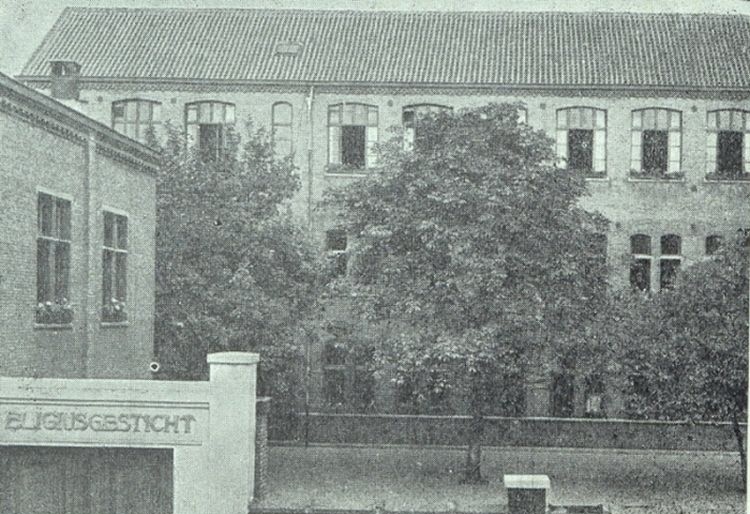
November, the 19th 1894
In the recently opened Saint-Eligius Institute, there was also a Saint-Lucas drawing school on impulse of Father Karsseleers , and this with the active support of the Brothers.
1906
When the Saint-Lucas school fell into decay, Father Karsseleers decided to found a parish Boy school besides the existing Brother school and this with the support of Frederik Belpaire.
From 1894 till 1919
The Brother school is a complete free school (= private and thus to pay), with the example program of the government, while the highest classes clearly followed a commercial section.
Already in the period before World War I, they built and rebuilt.
The number of pupils in the first period :
1894-95 : 151 -- 1895-96 : 295 -- 1896-97 : 327 -- 1897-98 : 369
Constant growth
In 1919 the school gets government supervision and becomes subsidized. From 1919 onwards, its population grows steadily. The highest number is to be found before the second World War, in 1934, namely 583.
During the school year 1937-1938 the school consists of 19 classes and 513 pupils. A first scientific-commercial class is added to the first scientific-modern class. The scientific-commercial division is now further explored.
A down grade and a new growth
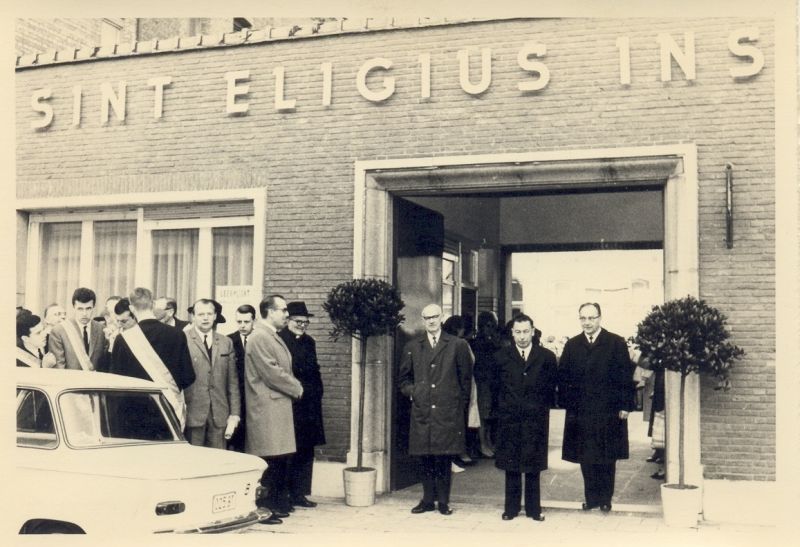
The last years before the start of the war, the constant growth will temporarily be broken. The school year 1945-1946 starts on the 23th of September with 361 pupils in the primary school and only 46 in the humanity section. A new headmaster arrives, Brother Kamiel Diddens, who will try and later on will succeed to get the humanity section successful again.
The school board will also be zealous to get the official recognition from 1945 onwards. The final examinations are undergone before a jury, even if it takes till 1951 before the two sections A6/A3 and A6/A/2 will be officially recognized and the diploma’s will be sanctioned.
The official recognition of the division A6/A1 book-keeping was got in 1953, and that of A6/A1 Secretariat in 1958 . In 1968-1969 the section A6/A1 Distribution was also set up and recognized.
The situation in 1973-1974 :
Primary school : 218 pupils
Secondary commercial division : 354 pupils
Economical higher education: 381 pupils
Historical backgrounds
With the summing up of these facts, it is interesting to try to find back the backgrounds .It is certainly not my intention to be complete or to give a fully 100% scientific justification. What I really want to try is to give an image of the time and the circumstances in which those people who founded the Saint-Eligius Institute, have been living and have been working.
In 1894, the end of the 19th century, the pastor of the Saint-Eligius parish wants to found a school. Why? I think we can find two reasons: first of all a social-economical one and a second one is of philosophical nature.
If we consider the population of the province of Antwerp for the period 1831-1961, then we can see the following: 1831: 350 000 inhabitants; 1913: 1. 020 000 inhabitants; 1961: 1. 444.000 inhabitants.
These numbers stand for the province Antwerp. In the agglomeration Antwerp, 400 000 inhabitants lived there in 1917, or more than 1 to 3 inhabitants of the province. If we compare this number with the number of inhabitants of the city of Antwerp in 1831, namely, 73. 342, that means 1 to 5, then it becomes clear that a complete change has been established in the run of the 19th century in social life , a change that has a very close connection with the economical development of our country.
The United Kingdom of the Netherlands under Willem I, meant a great advantage for our country especially for the industry. When in 1830 the revolution started, this meant the end of a boom period, because the industrial production in the South was destined to the export to the North. And now, the Belgian industry was only destined to the interior market. The change-over would take a long time, especially because of the fact that political reasons made the commercial treaties with the neighbouring countries almost impossible.
Economical crisis and famine
A new growth would have come around 1945, but a new economical crisis appeared, a crisis that especially in the Flanders was absolutely catastrophic. The most important reason was the aging process of the industrial apparatus, especially in the linen industry that still existed as a home industry with manual spinning-wheel and manual weaving-looms.
The 19th century is but the century of mechanization and abroad, especially in England, the production was extremely stepped up so that the prices were a lot lower than for example in the Flanders; this influenced the competition position of the Belgian industry.
In this climate of economical crisis, life became more expensive and when a potato disease almost eliminated the basic food of the poor people between 1845 and 1849, then famine and misery dominated the Flanders.
Industrial Revolution and its consequences
The Government, although its liberal character, was now obliged to act. In Parliament they were extremely divided about the measures to take. Above the two ruling party structures, Parliament was divided in conservative and progressive people. The conservatives wanted to return to older days: no mechanization and revival of the house industry; the progressives wanted to stimulate the mechanization and wanted to stop the house industry forever.
The progressives would win and from 1849-50 onwards, the economical situation improved again. From the midst of the 19th century, the mechanization of the production was stimulated also by the Government and also in Belgium, the first country on the continent.
A first logical result is the geographical regrouping of the population, in other words the industry is located in very advantageous places (e.g. near a harbour) and afterwards the population that works in these companies will live there because the transfer possibilities in the midst of the 19th century were almost non-existent (no bikes, no cars and only few railways). So, this really meant the escape from the land. People leave the countryside (agriculture and house industry) and moved towards the cities that grew immense.
Paralyzing and growth of the harbour of Antwerp
Besides the industrial revolution in the country in the 19th century, there is of course the history of the harbour in Antwerp that was and is still responsible for the growth or the depression of the city and its citizens.
The revolution of 1830 also paralyzed the harbour. Again the Dutchmen closed the Scheldt until they were obliged in 1831 by the Great Powers to keep the harbour free. In 1839 the treaty of 24 articles demanded for the navigation on the Scheldt per ton a tax that had to be paid of 1,5 guilder. The result was of course a regression of the navigation so that the harbour kept a medieval view for a long time. The number of people working over there, remained very little.
It takes till 1853 before the Antwerp council decides that the city and the harbour can expand outsides the Spanish settlements, namely north of “the old docks“. Outside the ramparts, a third dock would be burrowed, “The Kattenddijkdock”.
But the most important event is without any doubt the redemption of the Scheldt tax in 1863. After difficult negotiations the tax could be bought off for 16. 278. 566 BEF of which Belgium had to pay one third.
Now the navigation starts to grow: 638.000 ton in 1861, 2. 900. 000 ton in 1881. As for the dock workers , we can only guess about their number, although we may assume that around 1870, 5000 à 6000 harbour workers were already active. What is for sure: more and more workmen arrived from the adjoining towns and later on also from the more distant municipalities like Merksem, Ekeren, Hoboken, Wijnegem, Turnhout, Brasschaat, Lier. Most of these workmen settled down in the city.
Growth of the population number of the city of Antwerp
Thus, as well the industrial revolution in general as the continuing expansion of the harbour of Antwerp, result in the growing number of the population of Antwerp and so the city always expands further.
If we shape all those facts now, then we understand what Father Karsseleers writes in his memoires : The “Stuivenberg Quarter” before the existence of the Saint-Eligius parish (poor and wild) only half of it is developed, meadows gone through by streets, most of it pegged out by fences, in the “Pothoek” farms and gardeners companies.
When we try to imagine this district around 1880, then we only see a few scattered farms with enormous fields (the Antwerp Congo). The real Antwerp people avoided the neighbourhood of the Pothoek because it was so lonely over there. Although, more and more people settled down here, especially the working classes, from whom we can accept that they came from outside to work in the Antwerp industry, more specifically in the harbour. In 1880 already 13 000 people lived over there.
The new parish with Saint Eligius as the Patron Saint
Because of these people and to give them the necessary spiritual direction and help, Father Meeus, priest of Saint-Willebrordus, asks Cardinal Goossens that he can raise a new parish. The rest of the story is to be found in the memoires of Father Karsseleers, who was a priets of the Saint-Laurentius parish before.
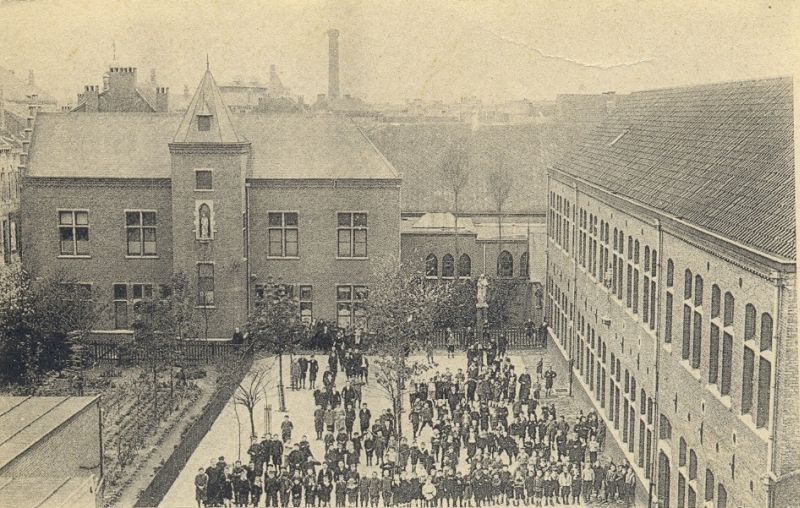
Monsignor Solvijns and Reverend Father De Bruyn, vice priest of Saint-Jan Borgerhout who were asked to do this, don’t dare to accept this task. Monsignor Sacré, Dean of Antwerp, recommends the Reverend Father, L. Karsseleers. He will be attended as the rector of the new parish with as patron Saint-Eligius. Therefore, the family Heirman donates a ground of about 1500 meters for the church, in the Family street. With the cooperation of the charitable Committee, one of the gentlemen and one of the ladies, and helped by gifts of anonymous people, grounds are bought; for instance a ground for a provisional chapel and a ground for a boys’ school. (later on the boys’ schools) in the Van Helmontstreet and a ground for a girls patronage in the Pothoek was donated… etc.
We can see that the new parish is organized firmly from the beginning onwards under the leadership of the charismatic priest. Committees are founded; there is also a convent for the Franciscan sisters, plans are made for the building of the church and there will be a patronage for girls; schools will also be built! Antwerp has got a new very active parish of which the priest is the one who fulfills his task seriously. But why build schools? The compulsory school attendance didn’t exist yet! Before 1894 children who got some education, also attended school?
Anti-clerical Trend
The answer to these questions has to be searched in the Belgian political history of the second half of the 19th century. The political life was conducted by two formations, more philosophical groups than real political parties, namely the liberals and the Catholics. After having cooperated rather well in the beginning, the doctrinaire attitude will disperse both groups and will even oppose them diametrically to each other. The famous controversial question between both parties was the education.
Already in 1828 liberals and Catholics had concluded a “Monstrous alliance” against the despotic government of Willem I. From a political opportunism, they had put the philosophical contradictions aside and after 1830 they lived together in mutual respect. That resulted in the first organic law on primarily education in 1842. Every community had to build one of more primary schools, but it could also adapt a free school, but that also meant they had to pay the expenses; Moreover Catholic religious education was obligatory.
Bit by bit the anticlerical trend predominates at the liberal side and they make a stand for the radical separation of Church and Government as well as for public education. The liberal Party Congres of the 14th of June 1846, at the initiative of “The Alliance Libérale”, and founded in 1841 by Th. Verhaegen, will organize the liberal party and will work out a liberal party program.
Article 3 of that program says : The organization of a public education at all levels and under the exclusive direction of the citizen’s authority, must give this education all the constitutional possibilities so that they can compete with the private institutions, without the support of the ministers of culture who are in charge of the education organized by the civil authorities.
It is thus quite clear that all goodwill has disappeared and that we can talk here about a radicalization. The result of this party congres was the fact that the liberals won the elections of 1847 with the greatest majority. From this year onwards till 1870 (with an interruption of only 5 years), the Liberals would govern the country alone.
A foretoken of the School Fight
The higher and the lower forms of educations already had their Organic laws, but the situation of the secondary education wasn’t done yet, and as most of the tribute electors came from this kind of education, it was very important for the liberals to be able to put their stamp upon them.
In 1850 the bill was presented by Rogier: the most important controversial questions at the conference were the regularization of the religious education and the restraint of the municipal autonomy. The clergy would only be invited to teach religious education just like the other teachers for all the other subjects, and thus not in function of “their authority” anymore. The bishops would not exercise any form of control anymore on the appointment of the teachers, although they would have liked that, so that the religious education of the pupils wouldn’t be neglected by certain teachers.
The law was approved and was issued on the First of June 1850. The result of this Organic Law was an encyclical from Pius X about the dangers that threatened Catholicism in Belgium as well as a sharper attitude from the Catholics towards the Government. In 1852 the Liberals lost 12 seats at the by-election, so that their majority was brought back to 6 seats.
The king nominated the moderate Liberal de Brouckère as the establisher. His “unionist” Government strived to reconciliation and could reach a convention concerning the secondary education although this convention was only partially brought into practice and remained a source of discussion between the Catholics and the Liberals.
In 1857 the Liberals gain power again and get that position till 1870. During this period the political and the ideological positions become more radical and the foundation for the school conflict is laid.
The school conflict
From 1878 till 1884 the Belgian political situation was completely dominated by the school conflict. In the large Liberal Ministry of Frère-Orban, the freemason Van Humbeeck was the Minister of Education. He introduced a bill about the primary education in 1879, the second Organic law. The bill’s most important provisions were :
- restriction of the municipal autonomy concerning the Primary Education, namely every municipality must possess at least one official state school, the municipality had not to accept free schools, all teachers had to be qualified by official high schools.
- Public education became neutral because the religious education was removed from the program and religious education had to be taught only after the normal class hours and on specific demand of the parents.
Van Humbeeck also introduced a bill for the Secondary Education in 1881: the government got the permission to raise secondary schools as they thought fit, at the expense of the municipalities and if necessary against the municipalities’ will. The municipalities couldn’t support any free college anymore. The result was “ a school conflict in the real sense of the word.
In the thick of the school fight
In 1879, the Lenten pastoral from the bishops dictated the following prayer : Free us, O Lord, from the godless schools and their teachers.” The words of the “Flemish Lion” were adapted to:: “they won’t get it, The Beautiful Soul of the child, despite the devilish tricks from the Protestant reign of terror.
After the bill’s vote there was an immediate reaction: teachers and pupils from the public schools as well as their parents didn’t receive the Sacraments from the bishops anymore.
Each priest had to found a free primary school in his own parish. The result of this was the resign of numerous teachers out of the public schools and the foundation of free schools with a lot of private money. The final result of this was that especially in the Flanders, there were 255 abandoned primary schools, sometimes with only one pupil, the headmaster’s son.
One of the persons who has gone through a great deal of this , is Camille Huysmans who writes about all this in his memoires : Yesterday’s nice municipal school had suddenly become a school of damnation. The parents who would dare to send their children to such a school, would be punished by the refusal of the Sacraments and what was even worse: nobody might ever enter God’s enemies houses anymore… I was then 8 years old… I stayed on the bench patiently. And I stayed there… alone. I was and I remained the only pupil of the municipal school for boys in Bilzen with its 2000 inhabitants.
“Accidental law”: stimulus for the Catholic education
In 1929 a memorial book, Our schools, was edited by the teaching personnel of the Antwerp Free Catholic Education. In the introduction, we read the following : 50 years are past since the cry for help was heard over the country to maintain the soul of the Catholic child. That cry found its echo in your soul, and the great deed of your offer created the wonder. Penny by penny was collected, stone by stone was built. And now, after half a century of hard labour the Free Catholic Education was flourishing, in full glory of his golden jubilee.
Now it is sure that this accidental law has started a movement that stimulated the Catholic education enormously, a stimulus that would never have been there otherwise. Especially in Antwerp; a lot of free schools, that were almost non-existent before, (in Antwerp, there were only two free primary schools for boys, and above all they were destined for orphans, and there were four girls schools).
It has to be mentioned that private schools often added a free division, but this determined especially the social distinction and probably this was also visible in the level of education. In 1878, a School Committee was founded of which Frederik Belpaire was treasurer and this even got the papal blessing.
New school laws
In 1884 the Liberals were beaten at the elections (they lost 25 seats) and the Catholic government Malou-Jacobs-Woeste had approved a new school law in that same year: the municipalities got the primary education again in own hands but they had to possess at least one school: they could also adapt free schools again; the religious education could also be part again of the educational program if the municipality wanted that, while twenty house fathers could ask for a special class where religious education was excluded; the nomination of teachers was free again.
In Antwerp, the school committee strived after the acceptance of the new founded free schools. But it would take till 1894 before they were all accepted. In 1895 the fourth Organic Law about the primary education was voted, the so called Law Schollaert. The free schools were no longer accepted, but all free schools that accepted the legal vast program and that accepted governmental inspection, got governmental allowances, just like the governmental ones and the accepted schools.
In 1914, a new school law is there: the fifth Organic Law about the primary education. The learning time has been brought from 12 to 14 years old (4th degree) and attending school was obligatory for all children.
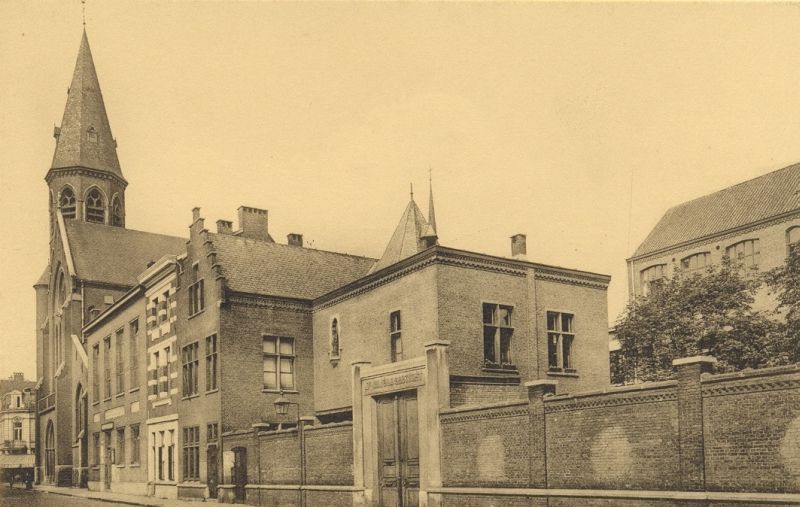
It is in connection with this that the foundation of Saint-Eligius must be seen. In 1894 Father Karsseleers also wanted a free school in his parish in reply to the bishops’ wish. As he was lacking pedagogical means, he then called for help at the Scheppers’ Brothers, who, from the beginning onwards, made the higher classes start in a commercial division.
Till 1919 this Brother school remained completely free, meaning free from governmental inspection or governmental subsidies, even though they were following the model study program from the government.
But now we see that in 1906 Father Karsseleers will found a parochial boys’ school with the help of the dean committee (that was in 1878 the former school committee), this at the Van Helmont street so to relieve the school in the “Everaert street”. (The Prayers’ book, Our schools, p. 43) The first school year started with 216 pupils, divided over 8 classes with Sir Henry Baeten as headmaster.
Growth of the parish schools in the city of Antwerp
Why a foundation of a parochial Boys’ school, 12 years after the foundation of the Brother school, in the same street and by the same person? The reason is obvious. The Dean Committee meant that a confessional school was a necessity for the Catholic Community and for the Church. And as the “accidental law” just eliminated the confessional school or they made life impossible, the Catholic Community saw this as her task to collect money so that a free education could be given to the children.
As the Catholic Community was shaken up by the action of the Liberal anti-clericals, this private education, was a great success and especially then in Antwerp. For example in 1879 these parochial schools already counted 7649 pupils, divided over 135 classes. In other words: this means almost 60 pupils per class, while the confidence of the population remains growing, and this shows the regular amount of the pupils’ rate sufficiently.
The school law of 1895 stated that the parochial schools couldn’t be accepted any longer, but that they would get subsidies if they fulfilled the demands of the law. The schools now got their subsidies without the intervention of the municipalities. That’s why the Dean Committee could found new schools in the new city’s districts; without being dependent of an Antwerp municipal government that was often unmanageable and that after the school law of 1884 misused his autonomy. In 1900 the parochial schools already counted 10765 pupils.
Two free boys’ schools in the same street
One of the new schools has been the parochial boys’ school at the Van Helmont street, that was especially designated to give a sound education in the free Catholic schools but therefore it was necessary that the pupils’ rate per class became smaller.
Besides this new parochial school, the Brother school also remained there, but with a diminishing number of pupils. (in 1905: 256; in 1912/ 190). One can imagine that the relation between the parish, that was owner of the rooms, and the Brothers, who had to leave these for the Parish schools, mustn’t have been very cordial in this particular period.
On the other hand, we should try to transpose to the Van Helmont street in this period, when there were two school entrances: one gate was the entrance to the Brother school, where French speaking boys paid for the education they got, while the second gate was the entrance for boys out of the neighbourhood, who spoke an Antwerp dialect and who got free education. Talking about social discrimination !
As to the teaching level in the Brother school during these years: the pupils’ rate (about 200) proves that it would have been sound, although there was no governmental supervision, neither in reading-matter, neither in pedagogical competence from the teachers. So, it is probably true that teaching is a gift (talent).
Interrupted growth of the Saint-Eligius Institute
The further history of the Saint-Eligius Institute shows a development in a rising degree as it concerns the rate of pupils. It is also clear that the Brothers continue the way they started in the very first beginning, namely with the foundation of a downright commercial education.
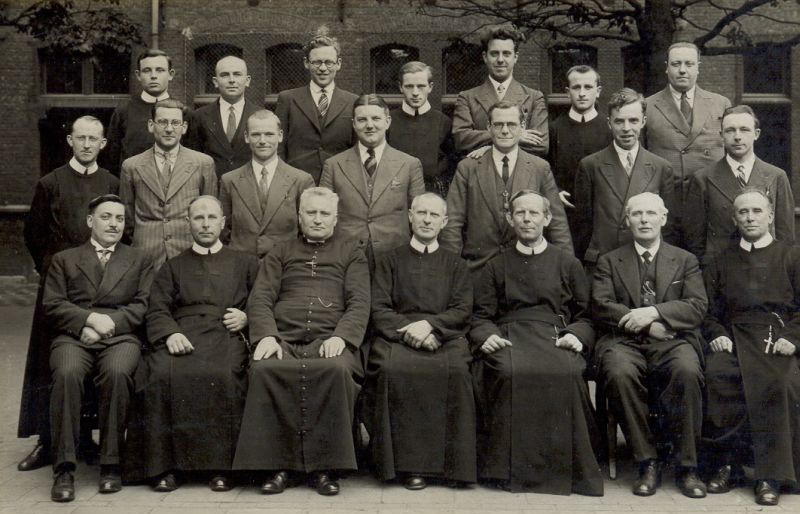
This rising line is interrupted during the last years before the second World War, still under the leadership of Brother Césaire van Bergen, who was already headmaster of the school since 1927.
The cause of this backwards movement is certainly worth to be mentioned namely the uncertain political situation during the years before and during the War. There was for instance the mobilization of a lot of teachers, so that from August 1939 the lessons had to be suspended in the three last years.
In May 1940, all education is temporarily finished. In 1942 there are troubles with the German occupiers concerning the content of certain history booklets. Therefore the headmaster is deprived of his office. In 1944-1945 there are bombings and the different rooms are occupied by the English, and afterwards by the Belgian soldiers; the city is shot with V-bombs and rackets.
But that is certainly not the only cause, because all schools had the same problems. The most important reason was rather one of organizational nature: the headmaster, Césaire Van Bergen, carried a school policy that was very successful around the years 1930, but later on that policy became completely out of date at the end of that decennium.
The Language policy becomes a stum- bling-block
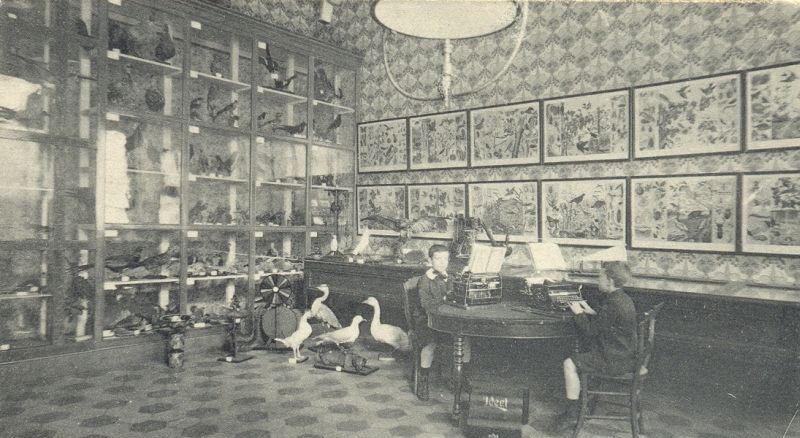
Especially the language policy would become a stumbling-block. Under his leadership the education remained only French, but meanwhile the Flemish Movement succeeded to make the public conscious of the language problem and the Belgian Government had to approve a series of laws (under the pressure of circumstances) that confirmed the “mono-language” of the Flanders and Wallonia.
The Catholic-Liberal department Renkin brought about the important language law of 1932. As far as it concerns education, the regional principle triumphed; this meant that in the Flanders only the Flemish education would be taught, in Wallonia, only the French, while in Brussels the former personality principle remained, namely: education will be given in the mother tongue of the child.
This law (regional language is educational language) was as well applicable to the free as to the official education in the Flanders so that the French free schools in the Flanders couldn’t deliver no legal diploma’s anymore in the secondary education that was destined for puypils who followed until then a French regime.
One of the schools that became victim of the new law was the Saint-Eligius Institute, where French was and remained the only educational language, so that, the attempts to get an homologation of the diploma’s, failed and that had a serious impact on the rate of the pupils. Who sends his children to a school where they had to pay for and where no legal diploma’s could be offered?
The Saint-Eligius Institute out of the misery
After the war in 1945, Brother Kamiel Diddens becomes headmaster of the school.. He’s going to carry on a school policy to save the institute. The school, especially the humanities, needed a new impulse (in the year 1945-46, there are only 46 pupils left in the humanities).
The new headmaster uses his relations to receive the homologation of the diploma’s. The education is now naturally in Dutch, the programs are adapted to the official program; the inspection is asked to be present at the end examinations of the pupils. In 1951 the divisions A6/A3 and A6/A2 are officially recognized and the diploma’s are homologized.
Since 1950 the school has expanded with an A6/A1 division “Accountancy”. This division gets official recognition and it also gets homologized diploma’s in 1953, the division Secretariat gets all this in 1958.
The Saint-Eligius Institute is expanding
As there is a great need for classes, the Saint-Fredegandus Institute at the Lakborslei in Deurne–North, is taken over by the Brothers of love. Then there comes a period of consolidation and there follows a further growth on pedagogical, administrative and materialistic domains.
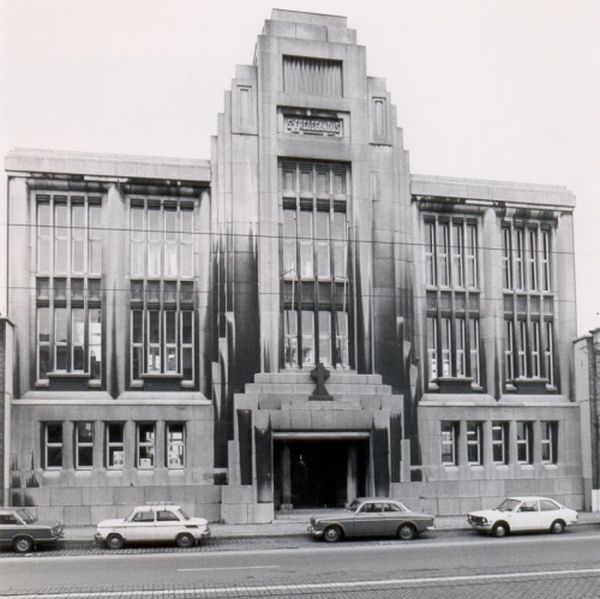
In 1968-1969, the Economical High School (secretariat-languages and accountancy) expands with a Distribution division that later on gets the name “Marketing”. In 1987-1988, a new division is added: Business Administration.
Refresher courses in evening school is very successful in different disciplines. From 199à-1991 the two year course of the High school becomes a three year course. From the First of September 1992 the secondary division also receives girls (in former years that was already so in the higher divisions and the 7th years).
Moves in the teaching sector
As a result of a decree on the Higher Education, all our divisions of the higher education are transferred to the Carl The Great High School on the 1st of September 1995. The Saint-Eligius Institute now consists (or exists again!) of a primary boy school and a secondary commercial school.
The next school years the Saint-Eligius Institute opens a professional Office and trade; in the technical division, Informatics is added, as well as a 7th year Medical-social administration and a 7th Commercial Web division.
From the 1st of September 2004, the responsibility of the “Establishing Authority” from the Saint-Mary Institute in Deurne is taken over by the VZW The Brothers of Scheppers-Saint-Eligius Institute.
Three Campus as one Scheppers Institute
The education activities, secondary education, are redistributed over three campus: Saint-Eligius Antwerp, Saint-Eligius Deurne and Saint-Mary Deurne; all the three under the name of Scheppers Institute Deurne-Antwerp (ASO-TSO-BSO).
The primary school in the Van Helmont street preserves its name Saint-Eligius Institute and from 1st September 2005, it becomes a mixed school.
During the school year 2017-2018 the Saint-Eligius Institute counts, together with the Scheppers Institute Deurne & Antwerp 1003 pupils; 283 are in the primary school and 720 in the secondary division. There’s an active staff of 148 personnel members.
The Saint-Eligius Institute has a future
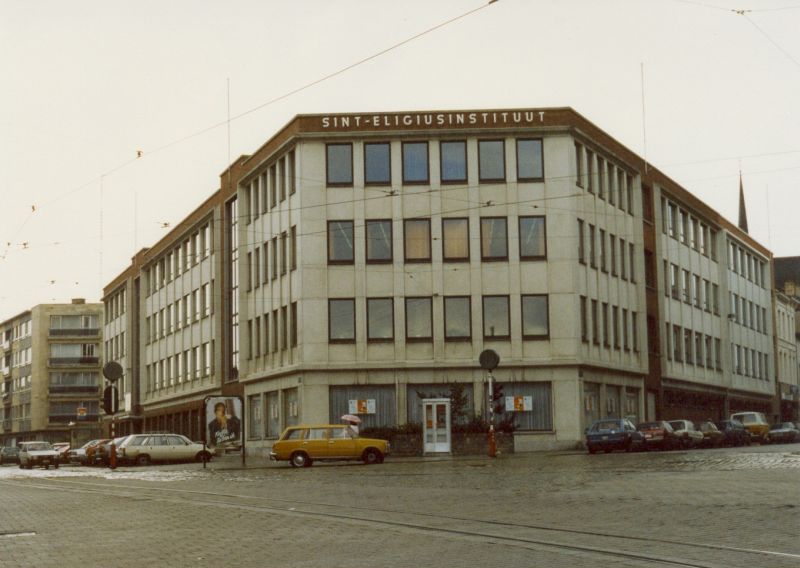
In 1974-1975 my colleague Ludo Van Camp wrote : This survey of 80 years teaching activities at the Van Helmont street can be closed with an optimistic note. The last years were years of a steady growth and development. The prospects for the next years points in the same direction. Not only figures can prove that; the best proof for this growth is to be found with people who were closely involved in the history of this school. Ask teachers, pupils and students; it can also be heard from old-pupils and old-students.
II hope that I’ve made clear how a school is an indicator for the evolution in the society and how the same school is the result of that social development. If I keep these two characteristics in front of me, then I dare say that the social, cultural and pedagogical role of the feasting Saint-Eligius Institute is now very important and it will be as important in the future, just as it was important in the past.
When we update this survey today, the conclusion of our colleague L. Van Camp is almost a prophecy. In different aspects (teaching, administration, social, cultural and others) there has been a move equal with the social evolution in the Flanders and more specific in Antwerp. This movement was picked up in a positive way by different areas and till today a qualitative high level of teaching is tried to be reached.
Lots of Brothers – 178 have been living there for a shorter or a longer period in one of the two communities- have brought the Saint-Eligius Institute, together with their leak cooperators, to a fabulous growth under the motto of their founder V. Scheppers : the honour to God, the work for me, the profit for my fellow-creature (from the spiritual testament of Mgr. V. Scheppers).

The Brothers Armand, Nestor and Pamfiel in the Saint-Eligius Institute in 1958
Source: “The History of a school” (1974) by Ludo van Camp, teacher at the Institute.





